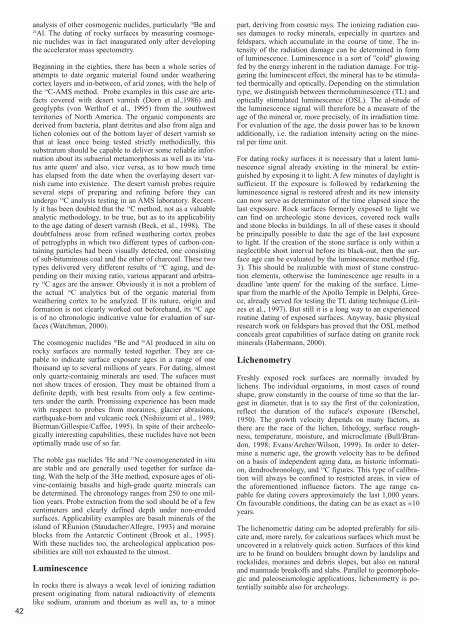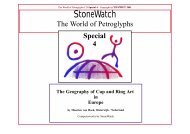Monts des Ksour" im Süd-Oranais / Nord-Algerien - StoneWatch
Monts des Ksour" im Süd-Oranais / Nord-Algerien - StoneWatch
Monts des Ksour" im Süd-Oranais / Nord-Algerien - StoneWatch
Erfolgreiche ePaper selbst erstellen
Machen Sie aus Ihren PDF Publikationen ein blätterbares Flipbook mit unserer einzigartigen Google optimierten e-Paper Software.
42<br />
analysis of other cosmogenic nucli<strong>des</strong>, particularly 10 Be and<br />
26 Al. The dating of rocky surfaces by measuring cosmogenic<br />
nucli<strong>des</strong> was in fact inaugurated only after developing<br />
the accelerator mass spectometry.<br />
Beginning in the eighties, there has been a whole series of<br />
attempts to date organic material found under weathering<br />
cortex layers and in-between, of arid zones, with the help of<br />
the 14 C-AMS method. Probe examples in this case are artefacts<br />
covered with <strong>des</strong>ert varnish (Dorn et al.,1986) and<br />
geoglyphs (von Werlhof et al., 1995) from the southwest<br />
territories of North America. The organic components are<br />
derived from bacteria, plant detritus and also from alga and<br />
lichen colonies out of the bottom layer of <strong>des</strong>ert varnish so<br />
that at least once being tested strictly methodically, this<br />
substratum should be capable to deliver some reliable information<br />
about its subaerial metamorphosis as well as its 'status<br />
ante quem' and also, vice versa, as to how much t<strong>im</strong>e<br />
has elapsed from the date when the overlaying <strong>des</strong>ert varnish<br />
came into existence. The <strong>des</strong>ert varnish probes require<br />
several steps of preparing and refining before they can<br />
undergo 14 C analysis testing in an AMS laboratory. Recently<br />
it has been doubted that the 14 C method, not as a valuable<br />
analytic methodology, to be true, but as to its applicability<br />
to the age dating of <strong>des</strong>ert varnish (Beck, et al., 1998). The<br />
doubtfulness arose from refined weathering cortex probes<br />
of petroglyphs in which two different types of carbon-containing<br />
particles had been visually detected, one consisting<br />
of sub-bituminous coal and the other of charcoal. These two<br />
types delivered very different results of 14 C aging, and depending<br />
on their mixing ratio, various apparant and arbitrary<br />
14 C ages are the answer. Obviously it is not a problem of<br />
the actual 14 C analytics but of the organic material from<br />
weathering cortex to be analyzed. If its nature, origin and<br />
formation is not clearly worked out beforehand, its 14 C age<br />
is of no chronologic indicative value for evaluation of surfaces<br />
(Watchman, 2000).<br />
The cosmogenic nucli<strong>des</strong> 10 Be and 26 Al produced in situ on<br />
rocky surfaces are normally tested together. They are capable<br />
to indicate surface exposure ages in a range of one<br />
thousand up to several millions of years. For dating, almost<br />
only quartz-containig minerals are used. The sufaces must<br />
not show traces of erosion. They must be obtained from a<br />
definite depth, with best results from only a few cent<strong>im</strong>eters<br />
under the earth. Promissing experience has been made<br />
with respect to probes from moraines, glacier abrasions,<br />
earthquake-born and vulcanic rock (Nishiizumi et al., 1989;<br />
Bierman/Gillespie/Caffee, 1995). In spite of their archeologically<br />
interesting capabilities, these nucli<strong>des</strong> have not been<br />
opt<strong>im</strong>ally made use of so far.<br />
The noble gas nucli<strong>des</strong> 3 He and 21 Ne cosmogenerated in situ<br />
are stable and are generally used together for surface dating.<br />
With the help of the 3He method, exposure ages of olivine-containig<br />
basalts and high-grade quartz minerals can<br />
be determined. The chronology ranges from 250 to one million<br />
years. Probe extraction from the soil should be of a few<br />
cent<strong>im</strong>eters and clearly defined depth under non-eroded<br />
surfaces. Applicability examples are basalt minerals of the<br />
island of RÈunion (Staudacher/Allegre, 1993) and moraine<br />
blocks from the Antarctic Continent (Brook et al., 1995).<br />
With these nucli<strong>des</strong> too, the archeological application possibilities<br />
are still not exhausted to the utmost.<br />
Luminescence<br />
In rocks there is always a weak level of ionizing radiation<br />
present originating from natural radioactivity of elements<br />
like sodium, uranium and thorium as well as, to a minor<br />
part, deriving from cosmic rays. The ionizing radiation causes<br />
damages to rocky minerals, especially in quartzes and<br />
feldspars, which accumulate in the course of t<strong>im</strong>e. The intensity<br />
of the radiation damage can be determined in form<br />
of luminescence. Luminescence is a sort of "cold" glowing<br />
fed by the energy inherent in the radiation damage. For triggering<br />
the luminescent effect, the mineral has to be st<strong>im</strong>ulated<br />
thermically and optically. Depending on the st<strong>im</strong>ulation<br />
type, we distinguish between thermoluminescence (TL) and<br />
optically st<strong>im</strong>ulated luminescence (OSL). The al-titude of<br />
the luminescence signal will therefore be a measure of the<br />
age of the mineral or, more precisely, of its irradiation t<strong>im</strong>e.<br />
For evaluation of the age, the dosis power has to be known<br />
additionally, i.e. the radiation intensity acting on the mineral<br />
per t<strong>im</strong>e unit.<br />
For dating rocky surfaces it is necessary that a latent luminescence<br />
signal already existing in the mineral be extinguished<br />
by exposing it to light. A few minutes of daylight is<br />
sufficient. If the exposure is followed by redarkening the<br />
luminescence signal is restored afresh and its new intensity<br />
can now serve as determinator of the t<strong>im</strong>e elapsed since the<br />
last exposure. Rock surfaces formerly exposed to light we<br />
can find on archeologic stone devices, covered rock walls<br />
and stone blocks in buildings. In all of these cases it should<br />
be principally possible to date the age of the last exposure<br />
to light. If the creation of the stone surface is only within a<br />
neglectible short interval before its black-out, then the surface<br />
age can be evaluated by the luminescence method (fig.<br />
3). This should be realizable with most of stone construction<br />
elements, otherwise the luminescence age results in a<br />
deadline 'ante quem' for the making of the surface. L<strong>im</strong>espar<br />
from the marble of the Apollo Temple in Delphi, Greece,<br />
already served for testing the TL dating technique (Liritzes<br />
et al., 1997). But still it is a long way to an experienced<br />
routine dating of exposed surfaces. Anyway, basic physical<br />
research work on feldspars has proved that the OSL method<br />
conceals great capabilities of surface dating on granite rock<br />
minerals (Habermann, 2000).<br />
Lichenometry<br />
Freshly exposed rock surfaces are normally invaded by<br />
lichens. The individual organisms, in most cases of round<br />
shape, grow constantly in the course of t<strong>im</strong>e so that the largest<br />
in diameter, that is to say the first of the colonization,<br />
reflect the duration of the suface's exposure (Berschel,<br />
1950). The growth velocity depends on many factors, as<br />
there are the race of the lichen, lithology, surface roughness,<br />
temperature, moisture, and microcl<strong>im</strong>ate (Bull/Brandon,<br />
1998; Evans/Archer/Wilson, 1999). In order to determine<br />
a numeric age, the growth velocity has to be defined<br />
on a basis of independent aging data, as historic information,<br />
dendrochronology, and 14 C figures. This type of calibration<br />
will always be confined to restricted areas, in view of<br />
the aforementioned influence factors. The age range capable<br />
for dating covers approx<strong>im</strong>ately the last 1,000 years.<br />
On favourable conditions, the dating can be as exact as ±10<br />
years.<br />
The lichenometric dating can be adopted preferably for silicate<br />
and, more rarely, for calcarious surfaces which must be<br />
uncovered in a relatively quick action. Surfaces of this kind<br />
are to be found on boulders brought down by landslips and<br />
rocksli<strong>des</strong>, moraines and debris slopes, but also on natural<br />
and manmade breakoffs and slabs. Parallel to geomorphologic<br />
and paleoseismologic applications, lichenometry is potentially<br />
suitable also for archeology.
















